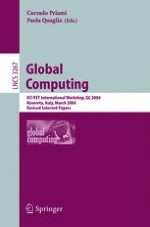2005 | Buch
Global Computing
IST/FET International Workshop, GC 2004 Rovereto, Italy, March 9-12, 2004 Revised Selected Papers
herausgegeben von: Corrado Priami, Paola Quaglia
Verlag: Springer Berlin Heidelberg
Buchreihe : Lecture Notes in Computer Science
